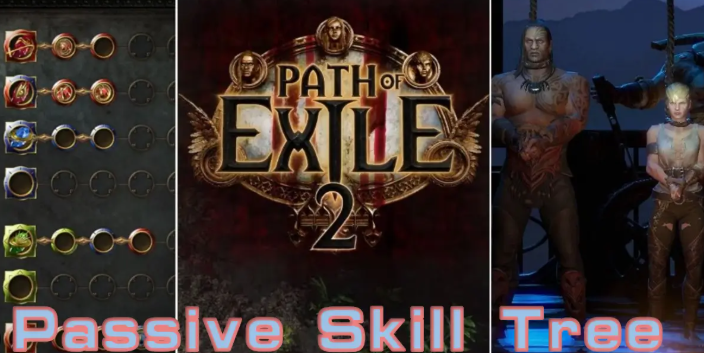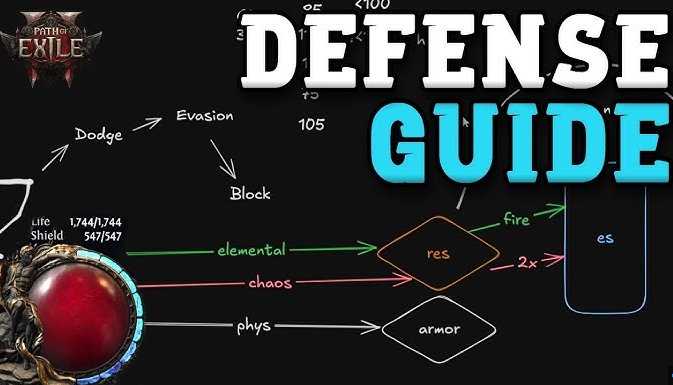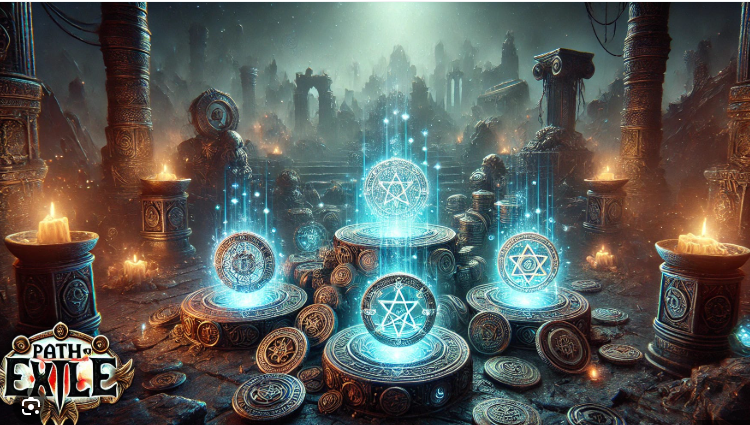- > Is Path of Exile 2 Worth Playing in 2025?
- > PoE 2 Cast on Shock: A Comprehensive Guide
- > PoE 2 Hyrri's Ire Guide: How to Get the Unique Armoured Vest
- > Path of Exile 2 Trial of Sekhemas Guide
- > PoE 2 Carapace Catalyst: Your Ticket to Tankiness
- > Path of Exile 2 Orb of Chance Guide--Your Ticket to Epic Gear (If You're Lucky)
PoE 2 Passive Tree Guide
When it comes to Path of Exile 2, one of the most defining features of your character’s power lies in its Passive Tree. This web of nodes determines how strong your build will be, how you scale damage, survivability, and what specific playstyle you'll adopt. But with hundreds of nodes to choose from, it’s easy to get overwhelmed. That's why we’ve put together this comprehensive PoE 2 Passive Tree Guide to help you understand how to navigate the tree, make effective choices, and optimize your build for success.
In this guide, we’ll break down everything you need to know about the PoE 2 Passive Tree, from the basics to advanced tips, so you can build a powerful character that can take on the toughest challenges in the game.
What is the PoE 2 Passive Tree?

In PoE 2, the Passive Tree is a massive skill web that represents your character’s potential growth. It’s where you choose your attributes, upgrade your defenses, and increase your damage output. Each class (Sorceress, Warrior, Ranger, Witch, Mercenary, Monk) starts at a different location on the tree, with a set of nodes they can access early on. As you level up, you can allocate Passive Skill Points to various nodes that grant you powerful bonuses, including:
- Stat boosts: Health, mana, damage, attack speed, etc.
- Elemental damage scaling
- Resistance and defense boosts
- Life and energy shield nodes
Understanding the Layout
The PoE 2 Passive Tree can look daunting at first glance. However, it follows a clear layout that makes navigating it more manageable:
-
Starting Area: Each character class starts at a different location on the tree. This gives you access to certain unique nodes, making each class’s build feel different.
-
Major Keystones: These are large, powerful nodes that drastically change how your character works. They can unlock new playstyles or change the way your character scales certain stats. Examples include Iron Grip, which boosts attack damage with strength, and Elementalist, which enhances elemental damage.
-
Cluster Nodes: These are clusters of smaller nodes that give you bonuses in specific areas, such as increased elemental damage, attack speed, or resistances.
-
Passives: These smaller nodes form the bulk of the tree. You’ll spend the majority of your points here, improving specific aspects of your build, whether it’s boosting defense, scaling damage, or increasing your survivability.
Key Passive Tree Types
Before diving into allocations, you’ll need to understand the different types of builds in PoE 2. These are some of the most common approaches to using the PoE 2 Passive Tree:
Damage-Focused Builds
These builds revolve around increasing your damage output. Depending on your class, you can focus on different types of damage:
- Physical Damage: Great for builds that rely on attack speed and weapon damage, such as Warriors and Rangers.
- Elemental Damage: Perfect for Sorceresses and Witches who focus on casting powerful elemental spells.
- Chaos Damage: A potent type of damage for Witch and Ranger classes that ignore enemy resistances.
Defensive Builds

If you prefer to play safe, a defensive build can make you nearly unkillable. Here, you’ll focus on boosting life, energy shields, resistances, and armor. Popular among tanky builds, such as some Monk and Mercenary characters, this type of tree can give you high sustain in battles.
Hybrid Builds
Hybrid builds combine aspects of both offense and defense. You’ll focus on scaling both your damage and survivability. These are typically great for newer players because they offer flexibility while leveling up.
Choosing the Right Starting Area
Each class starts in a different part of the PoE 2 Passive Tree, which influences your build's progression. For example:
- Sorceress starts in the upper left section of the tree, focusing heavily on spellcasting and elemental damage.
- Warrior starts on the far right side of the tree, which is ideal for physical damage and tackiness.
- Witch has access to powerful defensive and elemental damage nodes, focusing on survivability and debuffs.
Choosing the right class is crucial since the starting position gives you access to important nodes early on.
Optimizing Damage Scaling
Damage is the core of most builds in PoE 2, and scaling it efficiently is a top priority. Here’s how to approach it:
- Invest in the Right Damage Nodes: Look for nodes that increase your primary damage type, such as elemental or physical damage.
- Focus on Attack Speed or Cast Speed: Faster attacks or spells increase your damage output exponentially.
- Consider Crit Multiplier: Critical hits can massively boost your damage. Allocate points towards nodes that increase your critical hit chance and damage.
- Stack Damage Modifiers: Look for multipliers rather than additive increases. Damage multipliers scale much better in the late game.
Defense and Survivability Tips
Surviving in PoE 2 isn’t just about tanking hits—it’s about preventing damage and having the means to recover. Here’s how to boost your defenses:
- Health and Energy Shield: Focus on nodes that increase your life pool and energy shield. A good mix of both is vital for survivability.
- Elemental and Chaos Resistances: Ensure your character is resistant to elemental and chaos damage, especially in late-game encounters where these elements are more common.
- Armor and Evasion: Balance your armor (for physical damage mitigation) and evasion (for avoiding hits) to create a defensive juggernaut.
How to Allocate Points Efficiently
Efficient passive tree point allocation is one of the most crucial skills in PoE 2. Here’s how you can make your points count:
- Prioritize Critical Stats First: Early on, focus on the most crucial stats for your build. For example, if you're focusing on physical damage, prioritize strength or attack damage nodes.
- Take Keystones Later: While Keystones are powerful, they can change the way you play your build. Save them for later when you’re more comfortable with your chosen playstyle.
- Flexibility is Key: Be prepared to respec your tree when you realize certain nodes don’t synergize well with your build. In PoE 2, respeccing isn’t free, so plan your path accordingly.
Advanced Strategies for Endgame Builds
Once you’ve hit endgame, it’s time to make sure your passive tree is optimized for the toughest content. Here are a few advanced strategies:
- Focus on Scaling Over Time: Make sure your tree scales with higher-level content in mind, meaning prioritizing damage over time effects or multi-phase defenses like life leech and energy shield regeneration.
- Synergize with Ascendancy: Your ascendancy will also influence your tree, so be sure your points align with your class's ascendancy bonuses.
- Utilize the Right Flasks: Boost your damage and survivability with flasks that complement your tree, such as life or mana flasks for sustain or elemental flasks for damage.
The Importance of PoE 2 Currency

Having a well-crafted passive tree is one thing, but Path of Exile 2 currency is what allows you to upgrade your gear, craft the perfect item, and respect your tree when necessary. Make sure to gather enough PoE 2 currency to afford these upgrades and buy necessary items from vendors. Platforms like Kit4Game offer reliable sources for PoE 2 currency, helping you to boost your progression without spending hours farming.
Conclusion: Mastering the Passive Tree
Mastering the PoE 2 passive tree is one of the most rewarding parts of the game. The choices you make here will affect your entire experience, from early-game leveling to endgame dominance. Understanding how to scale your damage, boost your defense, and optimize your passive tree allocation will make a world of difference.
And remember, if you’re ever in need of PoE 2 currency for crafting or trading, platforms like Kit4Game are great resources to help you move ahead faster. Whether you're a seasoned pro or a newcomer, the PoE 2 passive tree offers endless opportunities to create the perfect character.
Happy exploring, Exile!


